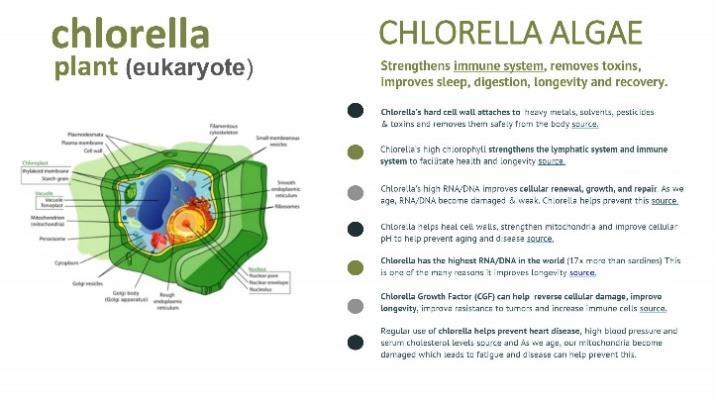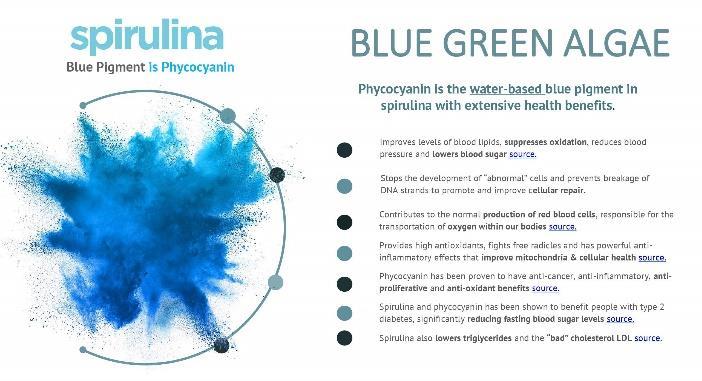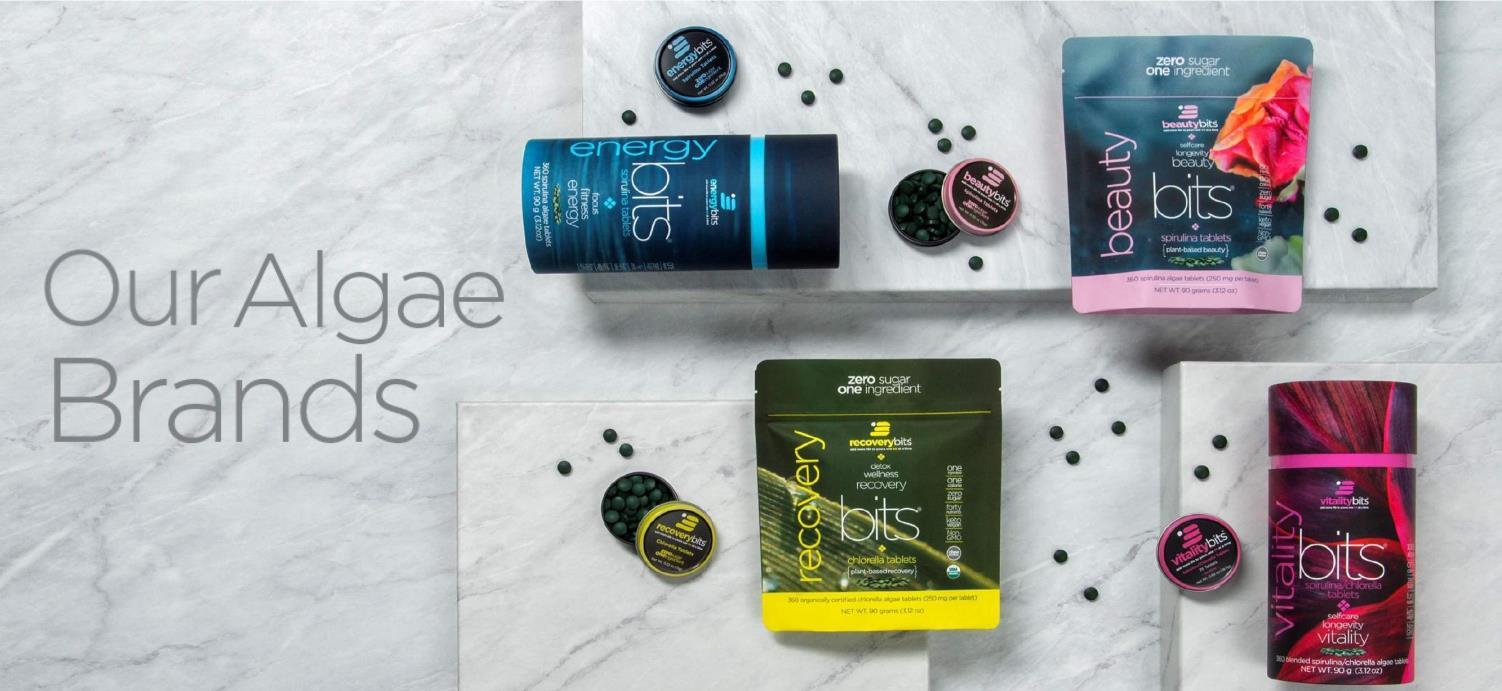




Catharine Arnston
ENERGYbits® Founder, CEO and Chief Scientific Officer


Superoxide dismutase (SOD), is a powerful antioxidant enzyme found in the cells of almost every living thing that depends on oxygen. There are three types of SOD (extracellular, intracellular and mitochondria), each of which neutralize oxygen free radicals. Oxygen free radicals are being constantly produced by our mitochondria in the process of converting the food we eat into energy or when needed by our white blood cells to defend us against invading infectious organisms.
SOD is found in small amounts in some foods but the SOD molecule in these foods is damaged in the gut which prevents it’s absorption (foods like broccoli or cabbage). That’s why spirulina algae is the most efficient source of SOD. Not only does spirulina have 1,000 – 10,000 x more SOD than other foods, the SOD in spirulina is instantly absorbed so there is little or no loss of SOD in digestion. Additionally, spirulina (like ENERGYbits tablets) contain the three minerals Zinc (ZN), Copper (CU) and Manganese (MN) that are essential for your body to use and make SOD,

bits Spirulina ablets ighest oncentra on of SOD

SOD is a powerful an o idant that neutralizes free radicals in the mitochondria to preventD A damage, in amma on disease . source
Spirulina has the highest concentra on of SOD in the world and contains the only form of SOD that is bioavailable andnot damaged during diges on our body s produc on of SOD slows down as you age which causes more mitochondria disease

SOD is one of the very few antioxidants that can enter the mitochondria inner membrane to protect the mitochondria and its DNA from damaging free radicals created during ATP production. https://www.britannica.com/science/mitochondrion https://www.ncbi.nlm.nih.gov/pmc/articles/PMC3211030/ https://www.sciencedirect.com/science/article/pii/S2090506817301550
SOD is a neuroprotector and helps prevent Alzheimer’s disease. But the problem is that as you age, your body produces less and less SOD until when you are in your 60’s it produces virtually none. As you age, you are more susceptible to diseases like Alzheimer’s and SOD has been proven to help prevent Alzheimer’s yet this is cruel twist of fate because just when you need SOD the most, your body isn’t producing it. https://www.ncbi.nlm.nih.gov/pmc/articles/PMC8241491/#RSOB210013C13



SOD is a powerful antioxidant scientifically proven to protect the mitochondria. The superoxide dismutase (SOD) in spirulina algae is 1,000 x more concentrated than any other food or supplement source of SOD. And since ENERGYbits´ spirulina algae tablets are toxin free and tested for purity by third-party FDA approved labs, our spirulina tablets not only provide the most concentrated source of superoxide dismutase in the world, they are also the safest and easiest to take (just swallow with water). Each ENERGYbits® spirulina tablet contains 3,306 IU per gram of SOD compared to 5 IU of SOD per gram in cabbage and since the SOD from cabbage (or SOD supplements) is damaged during digestion, it never reaches the mitochondria. This is in contrast to the SOD found in ENERGYbits spirulina tablets which are absorbed instantly. Spirulina is a bacteria and does not have a cellulose wall, so its nutrients are absorbed instantly and virtually bypass digestion. This allows all the SOD to reach the mitochondria. https://www.sciencedirect.com/science/article/pii/S1756464620301419
But you won’t get SOD from just any spirulina because SOD is an enzyme and enzymes are destroyed with high heat. Virtually all other algae companies (except ENERGYbits®) use high heat to dry their spirulina algae, so all the SOD is destroyed. This never happens with spirulina tablets from ENERGYbits® because ENERGYbits® is one of the very few algae companies (possibly the only one) NOT using high heat to dry the algae This ensures ALL the enzymes in our spirulina are preserved/active, including SOD. The importance of this can’t be understated.
Raw spirulina algae like ENERGYbits® algae tablets or frozen spirulina are the only two best sources of concentrated SOD (superoxide dismutase). But frozen spirulina is difficult to get, difficult to use and difficult to travel with. ENERGYbits® spirulina tablets are a better choice. All the enzymes in our spirulina algae including SOD are preserved and active. This is one of the reasons why our algae is a premium product and works so efficiently in your body. In contrast, virtually all the lower priced algae tablets are dried with high heat because their lower prices require them to dry their algae quickly, get it to market quickly and sell it quickly. But since high heat kills enzymes, these lower priced spirulina products do not contain any active/alive SOD.



SOD has been studied for its therapeutic benefits and has been proven to have therapeutic benefits in inflammatory diseases, cancer prevention, diabetes II, cardiovascular diseases and respiratory diseases. https://www.sciencedirect.com/science/article/pii/S1756464620301419

Antioxidants like SOD importance in redox signaling https://www.ncbi.nlm.nih.gov/pmc/articles/PMC3151424/
SOD used to prevent prostate cancer https://www.glisodin.org/project/the-effect-of-exogenous-superoxidedismutase-sod-on-caspase-3-activation-and-apoptosis-induction-in-pc-3-prostate-cancer-cells/
Redox signaling improves with SOD which controls ROS in mitochondria https://healthysignals.wordpress.com/2010/12/13/redox-signaling-is-healing/
SOD used to reduce physical/ mental fatigue and anxiety with just 140 IU per day (as comparison - 30 ENERGYbits spirulina tablets contain 24,800 units of SOD) https://pubmed.ncbi.nlm.nih.gov/24949549/
As you age, you experience more oxidative stress and you produce less SOD https://www.ncbi.nlm.nih.gov/pmc/articles/PMC5551541/
Lack of SOD causes mtDNA damage https://pubmed.ncbi.nlm.nih.gov/9457866/
Levels of SOD drop as you age https://pubmed.ncbi.nlm.nih.gov/11249925/
Therapeutic uses of SOD- includes reducing cancer https://www.ncbi.nlm.nih.gov/pmc/articles/PMC5969776/
SOD is critical for protecting mitochondria
https://www.tandfonline.com/doi/full/10.1016/j.ajme.2017.09.001 https://www.sciencedirect.com/science/article/pii/S2090506817301550
There are many and various types of free radicals in biological systems, however, those derived from oxygen, generally termed reactive oxygen species (ROS) are the most damaging. Oxygen is highly susceptible to free radical formation because of its electronic structure which has two unpaired electrons in separate electronic orbitals. Oxygen radicals such as superoxide anion (∗O2) and singlet oxygen, (1O2 ) are easily generated from the sequential reduction of this molecular oxygen
Free radicals are constantly formed through normal cell reactions or processes. In many cases, they are generated for beneficial reasons, for instance they are used for destruction of microbes and pathogens by white blood cells. It is documented that oxygen radicals are involved in intercellular and intracellular signaling. Precisely, superoxide anion and hydrogen peroxide have been reported to act as mitogens, thereby promoting the rate of DNA replication and cell proliferation in a variety of cultured cells.9,10 But, in excess amounts, oxygen-derived radicals (ROS) are very harmful to living organisms and are capable of generating other free radicals that could be even more destructive.
Before we consider how other radicals are derived from oxygen radicals, it is necessary to mention some normal physiological processes that lead to formation of oxygen radicals. Mitochondrial energy production


pathway (MEPP) is a major source of oxygen radicals. These radicals are formed as oxygen is reduced along the electron transport chain which is located in the inner membrane of the organelle. Phagocytic leucocytes (white blood cells) especially neutrophils produce abundant of oxygen radicals through NADPH-Oxidase activity (O2 + e → ∗O2 ) as effort to destroy invading pathogens in defense or protection of the host organism.11 Oxygen-derived radicals are also produced as integral metabolites in cascades of enzyme catalyzed reactions. Exposure to ionizing radiation is well known to promote oxygen radical formation within biological systems through radiolysis (interaction of radiation and water).12 Hypoxia or/and hyperoxia condition in cells has been noted to generate numerous oxygen-derived radicals.13 Besides, a couple of therapeutic drugs such as acetaminophen have been reported to cause oxidizing effects on cells, consequently leading to formation of oxygen radicals through the activity of drug metabolizing enzymes known as cytochrome P-450 system.14
Superoxide anion (∗O2) which is constantly being generated through different pathways or chain reactions cause the formation of several other reactive species.15 It can directly produce hydroxy radical (∗OH) (∗O2 + 2e → ∗OH) or indirectly from hydrogen peroxide which results from its dismutation by SOD (H2O2 + e → ∗OH), through Fenton reaction which occurs in the presence of Fe2+ ∗OH is the most dangerous free radical and major culprit in free radical–mediated toxicity in cells.16,3 Both ∗O2 and ∗OH can individually act on lipid membranes to promote the formation of lipid radical (∗L) which in the presence of oxygen is capable of generating lipid peroxy radical (∗LOO)3
These radicals attack lipid membranes to initiate the most devastating effect of oxidative stress which is membrane lipid peroxidation. Peroxidation of membrane results in huge compromise of the structural and functional integrity of the cell characterized by altered membrane permeability,17 dysfunctionality of membrane receptors,18 decreased activity of membrane-bound enzymes19 and increased membrane rigidity which decreases membrane fluidity.20
The possibility of free radicals directly attacking membrane proteins, induce lipid-lipid, lipid-protein and protein-protein cross linking also exist.21 Peroxynitrate (ONOO ), a powerful oxidant is formed when ∗O2 reacts with nitric oxide radical (∗NO) in the presence of arginine and NADPH-Oxidase enzyme. (ONOO ) is a damaging oxidant which can cause lipid peroxidation, protein oxidation, protein nitration and enzyme inactivation. It can also react with carbon dioxide to generate nitrosoperoxycarbonate (ONOOCO2 ) which readily disintegrate to form carbonate radical and nitrogen dioxide radical (∗NO2 ) (Fig. 2). These two radicals are believed to be the main actors in peroxynitrite-related cellular damage. Besides, there are a couple of other reactive species that result from superoxide anion.
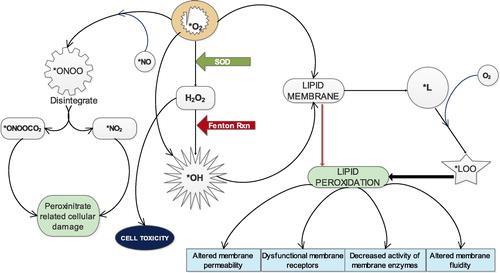


Superoxide dismutase (SOD), catalase and glutathione peroxidase are antioxidant enzymes with fundamental and indispensable roles in the antioxidant protective capacity of biological systems against free radical attack. But since catalase is absent in mitochondria, superoxide dismutase (SOD) is even more critical. The superoxide radical (∗O2) or singlet oxygen radical (1O2 ) generated in tissues through metabolism or reactions in cells is catalytically converted to hydrogen peroxide (H2O2) and molecular oxygen (O2) by superoxide dismutase (SOD). H2O2 when accumulated is toxic to body tissues or cells. SOD breaks down H2O2 into water and molecular oxygen, which stops free radical-induced damage

Since catalase is not found in the mitochondria, superoxide dismutase (SOD) is even more essential to protect Mitochondria and mtDNA from free radical damage. The role and effectiveness of this first line defense antioxidants is indispensable in the entire defense strategy of antioxidants, especially in reference to super oxide anion radical (∗O2) which is perpetually generated in normal body metabolism. https://www.tandfonline.com/doi/full/10.1016/j.ajme.2017.09.001 https://www.sciencedirect.com/science/article/pii/S2090506817301550
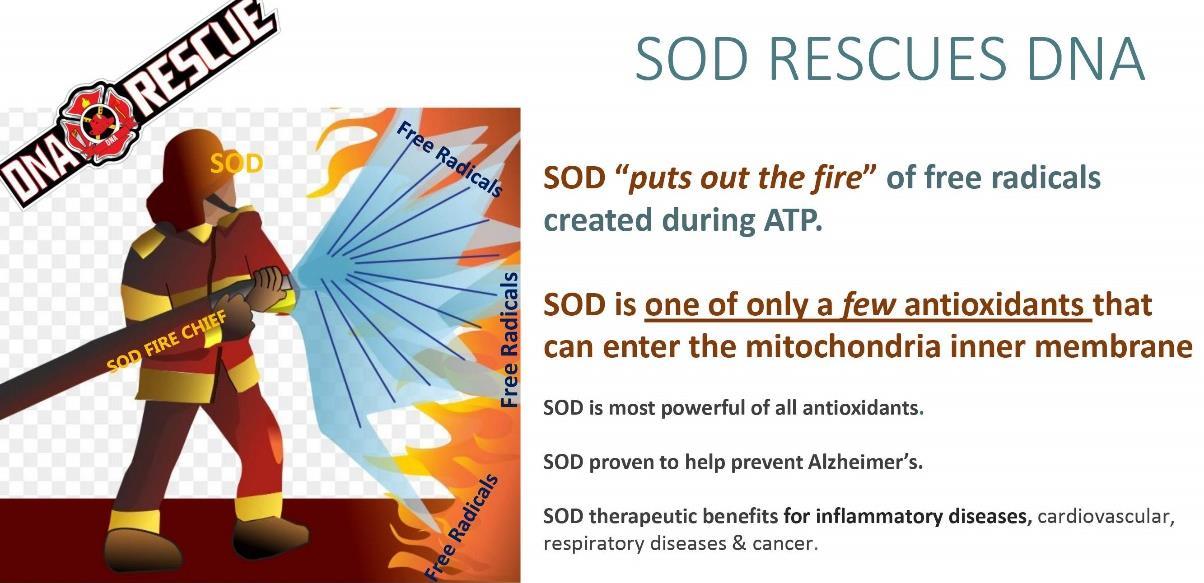

Raw spirulina algae like ENERGYbits® algae tablets provide a concentrated source of SOD (superoxide dismutase) because all of the enzymes in our algae including SOD are alive so they protect mitochondria

Mitochondria produce ATP which is the energy used by cells for all metabolic processes. But the process of ATP production also creates free radicals which damage the mitochondria and its Mitochondria DNA

Mitochondria have the greatest influence on our health. But as we age we have fewer mitochondria, and the few that stick around are mutated so they function poorly and cause cellular damage. Research shows that Parkinson’s or Alzheimer’s patients have high mitochondria mutations https://mitocanada.org/understand/


Which cells have the most mitochondria
https://lisbdnet.com/what-cell-has-the-most-mitochondria/#What_cells_have_most_mitochondria
What causes mitochondria aging
https://siimland.com/what-is-the-mitochondrial-theory-of-aging/
Red light therapy benefits mitochondria
https://patriotdirectfm.com/2020/02/health-benefits-of-red-light-therapy/
Brain cells have 2 million mitochondria per brain cell

https://www.ncbi.nlm.nih.gov/pmc/articles/PMC5687842/#:~:text=If%20mitochondria%20are%20present%20 at,mitochondria%20per%20cell%20is%20reasonable.
Elite athlete mitochondria live only 15 days https://www.nature.com/articles/d41586-021-00817-2
Mitochondria are unlike other cells or organelles (miniature organs within the cell), they have two membranes, an outer one and an inner one. Each membrane has different functions.
Inner membrane: This membrane holds proteins that have several roles. Because there are no porins in the inner membrane, it is impermeable to most molecules. Molecules can only cross the inner membrane in special membrane transporters. The inner membrane is where most ATP is created.
Very few antioxidants can pass into the inner membrane of the mitochondria to protect it from free radicals generated by APT production. But SOD is one of the few antioxidants along with other antioxidants involved in the electron transport chain that can cross this membrane to reduce and remove free radicals https://www.ncbi.nlm.nih.gov/pmc/articles/PMC3211030/
Outer membrane: Small molecules can pass freely through the outer membrane which contain proteins called porins, that form channels to allow proteins to cross. The outer membrane also hosts a number of enzymes with a wide variety of functions. https://www.medicalnewstoday.com/articles/320875#DNA
Mitochondria and the mitochondria DNA (mtDNA) play a critical role in your health which is why you need to protect them! Unfortunately this is not an easy thing to do because mitochondria DNA are located in the inner membrane of the mitochondria which is also exactly where ATP production occurs.



During ATP production, free radicals like Superoxide are released. Since very few antioxidants can penetrate the mitochondria inner membrane to neutralize them, these free radicals damage the mitochondria DNA which then leads to cellular disfunction, cell membranes damage and increased disease/aging especially where mitochondria are highly concentrated such as in your brain, heart and organs. https://www.genome.gov/genetics-glossary/Mitochondrial-DNA
A P can’t be stored and your average cell used 10 billion A P per day. hat’s why protecting your mitochondria (that generate your ATP) is critical to your health, energy and longevity
https://www.ncbi.nlm.nih.gov/pmc/articles/PMC4684129/
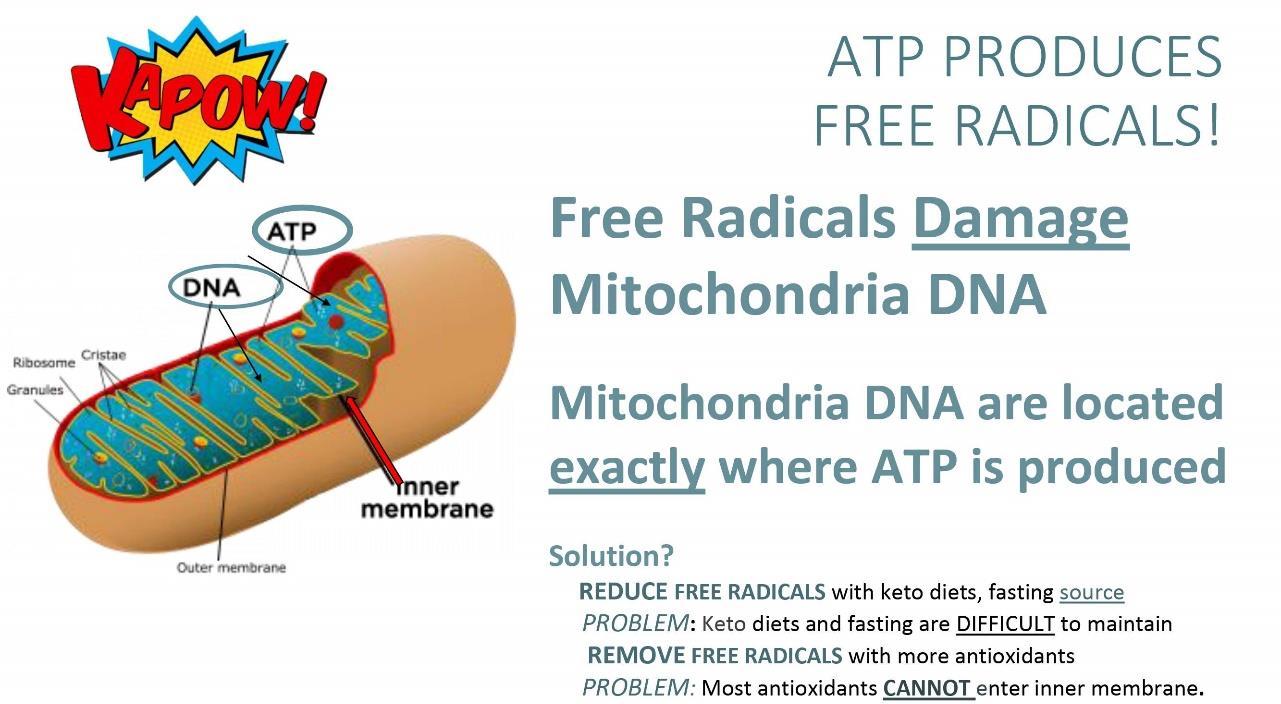
The greatest mitochondria damage occurs after the age 65 when there are fewer mitochondria, when your mitochondria are reproducing slower and when they have higher rates of mutation. This high rate of mutation is the primary cause of disease especially in our brain, heart and other parts of our body that require high energy. https://mitocanada.org/understand/
In fact, scientists have now realized that mitochondria health determines human lifespan
https://www.ncbi.nlm.nih.gov/pmc/articles/PMC2801852/
https://www.ncbi.nlm.nih.gov/pmc/articles/PMC4779179/ https://www.ncbi.nlm.nih.gov/pmc/articles/PMC2861545/
https://www.ncbi.nlm.nih.gov/books/NBK9896/
Source: https://mitocanada.org/understand/
Mitochondria feed the rest of your cells and respond instantly to good nutrition like spirulina algae or low carb diets. You can reduce mitochondria damage with intermittent fasting, keto diets and reduced your carbs. But


the best solution is to take spirulina tablets like ENERGYbits® which are highly concentrated with both SOD and nutrition (64% protein, 40 vitamins/minerals) but NO carbs (they are a ketogenic food that is also great for intermittent fasting). Each ENERGYbits® spirulina tablet provides over 3,000 international units of Superoxide dismutase. This is the highest concentration of SOD in the world
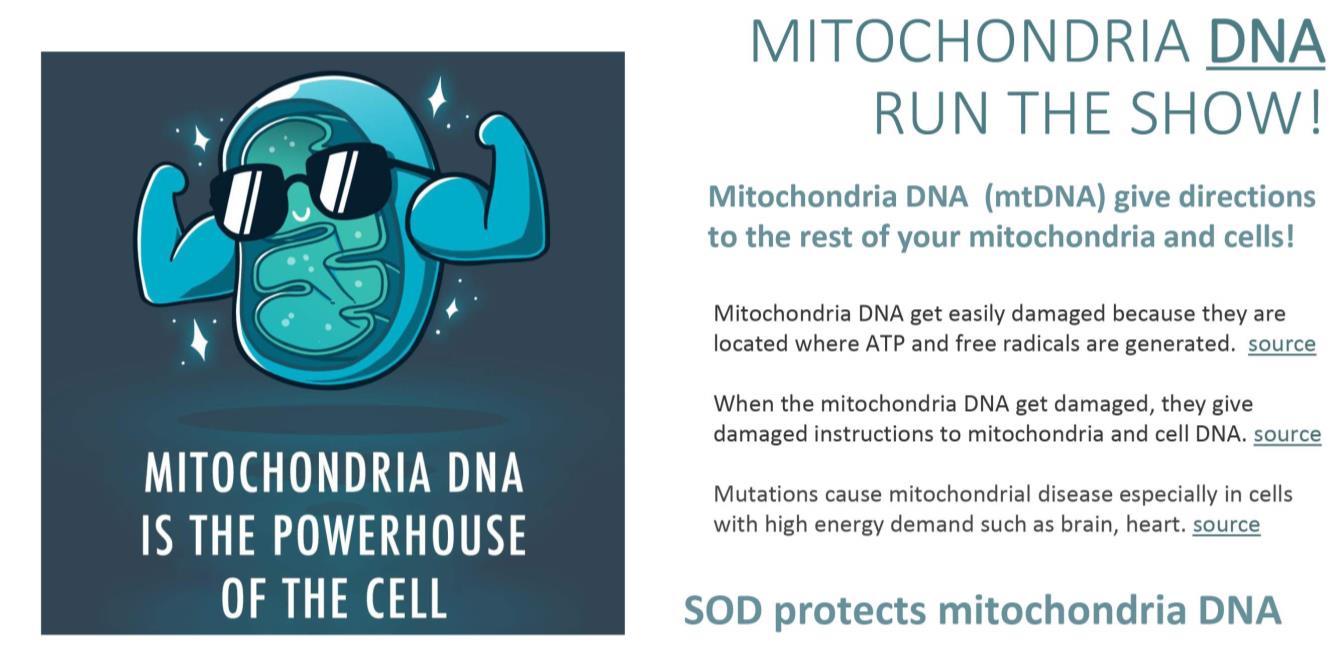
Mitochondria DNA are damaged by ROS free radicals produced during the ATP process. This is because ATP production and mtDNA are both located in the same place –the inner membrane of the mitochondria. The close proximity of the mitochondria DNA to ATP production is why mitochondria DNA have a lifespan of only 15- 30 days. This compares with the cellular DNA, which are NOT located in the mitochondria and have a lifespan of your entire life. The mitochondria DNA are simply too close to the “fire” of A P production and the “sparks” from the fire (free radicals) constantly damage them. In contrast, your cellular DNA are NOT located in your mitochondria so they are not exposed to the “sparks” of A P production (free radicals) and rarely get damaged by the ATP production process. https://www.biorxiv.org/content/10.1101/2020.02.15.950410v1.full https://medium.com/@leebachacko/unique-parental-inheritance-of-mitochondria-c9b4cea47d9a
The best antioxidant to protect mitochondria is SOD. ENERGYbits® spirulina has the highest concentration.
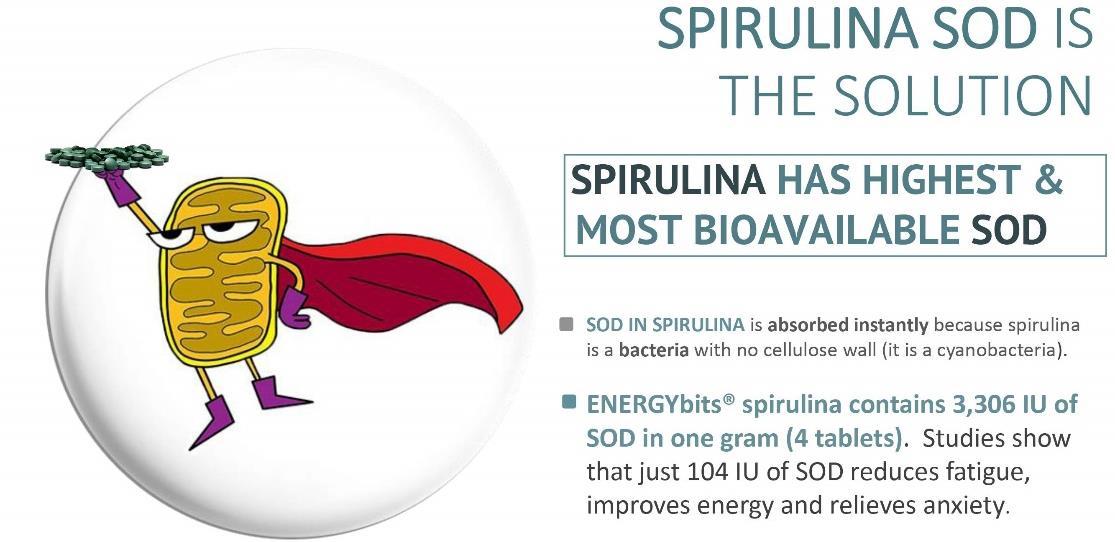

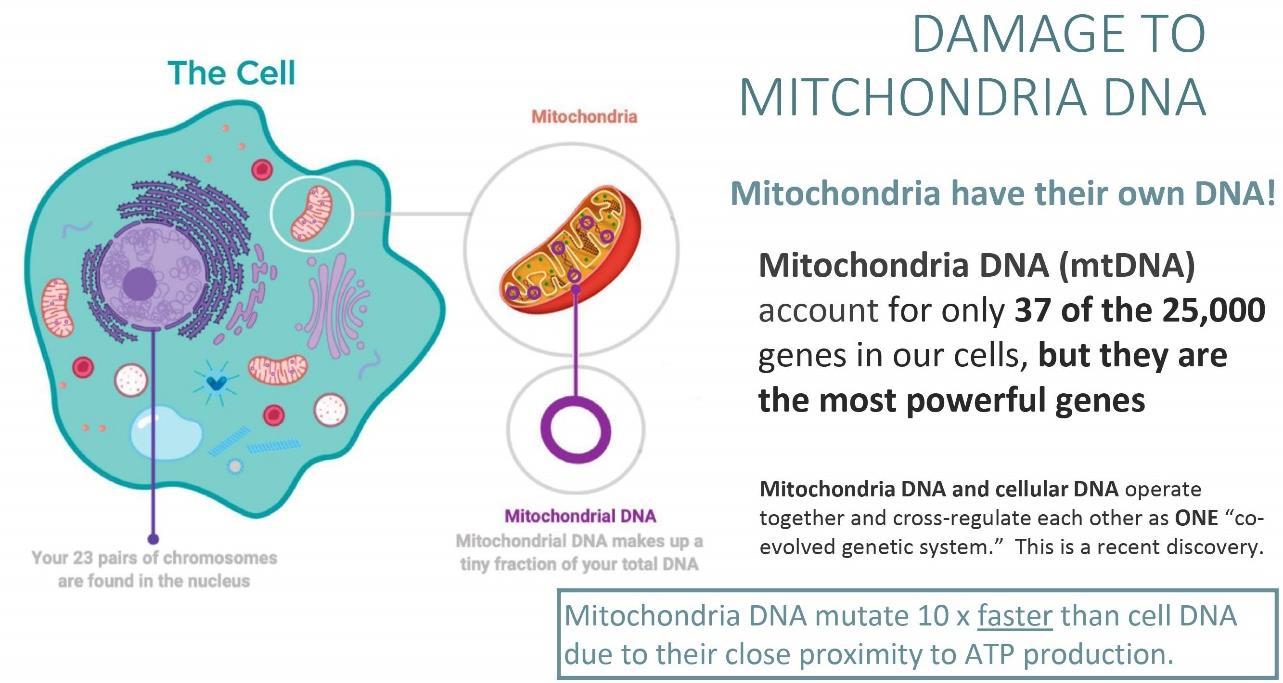
ThemitochondrialDNA(mtDNA)accountsforonly37ofthetotal25,000genesthatareexpressedinour cellshowevertheyarethemostpowerfulDNAinourbody. InterestinglyallofourmitochondriaDNAis inheritedfromourmother(unlikecellDNAthatisinheritedfrombothourmotherandfather)
https://www.joliecanoli.com/blog/tag/what+is+mitochondria University California, Dept Gerentology
https://gero.usc.edu/2018/07/05/mighty-mitochondria-flex-dna-power-to-help-nucleus-run-the-cell/

Mitochondria DNA mutate 10 x faster than our cellular DNA. This is because the mitochondria DNA are located EXACTLY where ATP production occurs so they experience far greater damage from free radicals created during the ATP production process When the mitochondria DNA are damaged, they sends signal to the cellular DNA to respond which can cause mtDNA death (miophagy).
Mitochondria DNA mutate so quickly and live for such a short period of time ( 14 -30 days) when they are damaged, they replicate in a damaged form and this leads to increased cell disease and aging. https://bscb.org/learning-resources/softcell-e-learning/mitochondrion-much-more-than-an-energy-converter/
Prokaryotes (bacteria cells like spirulina) are the oldest life forms on Earth and came into existence long before eukaryotes (human cells) graced the planet. The first prokaryotes are thought to have appeared at least 3.8 billion years ago, whereas eukaryotes (human/plant cells)) only emerged 2.7 billion years ago. So, by the time human cells came along, prokaryotes (bacteria like spirulina) had been alive for billions of years.
The leading hypothesis of how our human cells and mitochondria came about is that they evolved from endosymbiosis. The endosymbiotic theory suggests that cell organelles like mitochondria were once independent cyanobacteria (like spirulina) that formed symbiotic relationships with larger bacteria when they were engulfed by them and lived inside them. Over many years of evolution, the two became so dependent on

one another that they could no longer live alone, and complex eukaryotic cells (human cells and plant cells) were formed as a result.

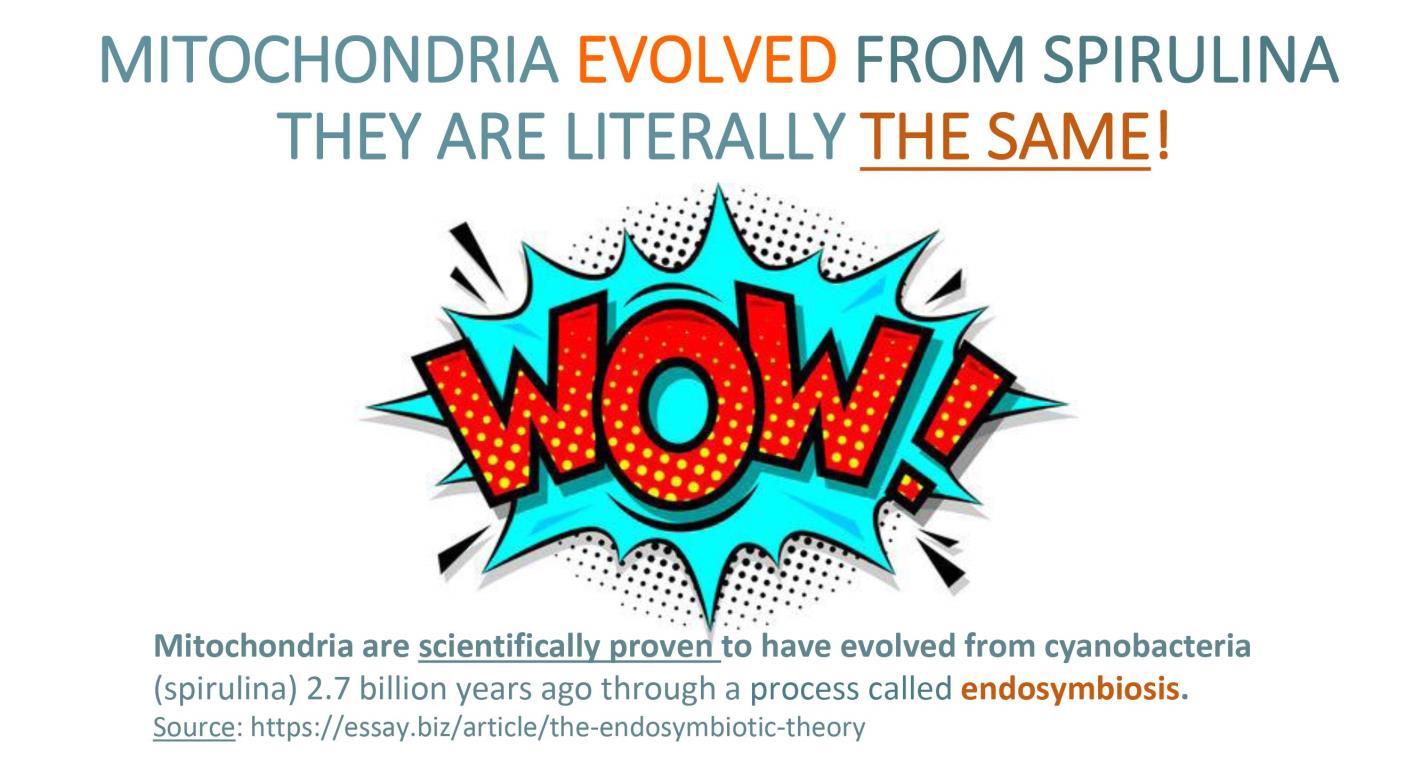
This theory is further supported by the fact that both mitochondria and cyanobacteria (like spirulina) contain their own DNA and that, both reproduce by splitting in two.
https://openstax.org/books/biology/pages/23-1-eukaryotic-origins https://m.youtube.com/watch?v=FGnS-Xk0ZqU
What is a Prokaryote (pronounced PRO-KAR-ee-ote)
Prokaryotes are unicellular organisms that don’t have a membrane-bound nucleus and other organelles. Prokaryotic cells tend to be small, simple cells like cyanobacteria (spirulina algae) and are smaller (around 0.1-5 μm in diameter). https://rsscience.com/eukaryote-prokaryote/
What is eukaryote (pronounced YOU-KAR-ee-ote )
The name “ ukaryote” literally means to possess a “true nucleus.” Eukaryotes are organisms whose cells have a membrane-enclosed nucleus and other organelles. These membranes are similar to the cell membrane, which is a flexible film of lipid bilayers. Organelles are internal structures responsible for a variety of functions, such as energy production and protein synthesis. Eukaryotic cells (like Chlorella algae and human cells) are relatively larger (around 10-200 μm) and more complex.



Prokaryotes (bacteria cells like spirulina) are the oldest life forms on earth and came into existence long before we eukaryotes graced the planet. The first prokaryotes are thought to have appeared at least 3.8 billion years ago, whereas eukaryotes (human/plant cells)) only emerged 2.7 billion years ago. This means that, by the time human cells (eukaryotes) came along, prokaryotes (bacteria like spirulina) had been alive and evolving for 1.5 billion years
It’s difficult to know e actly where eukaryotes came from, but the leading hypothesis is that they evolved from endosymbiosis. The endosymbiotic theory suggests that cell organelles like mitochondria and chloroplasts were once independent organisms that formed symbiotic relationships with other prokaryotes. At some point, they were engulfed by larger prokaryotes and lived inside them. Over many years of evolution, the two became so dependent on one another that they could no longer live alone, and complex eukaryotic cells were formed as a result Fun video: https://www.youtube.com/watch?v=FGnS-Xk0ZqU




Source: https://essay.biz/article/the-endosymbiotic-theory Endosymbiotic theory https://www.sciencedirect.com/topics/biochemistry-genetics-and-molecularbiology/endosymbiosis#:~:text=Primary%20endosymbiosis%20refers%20to%20the,membranes%20surround% 20mitochondria%20and%20chloroplasts
Crazy as it sounds, cyanobacteria (spirulina) and mitochondria are basically the same. No wonder spirulina algae contains nutrients like SOD your mitochondria need to live.



